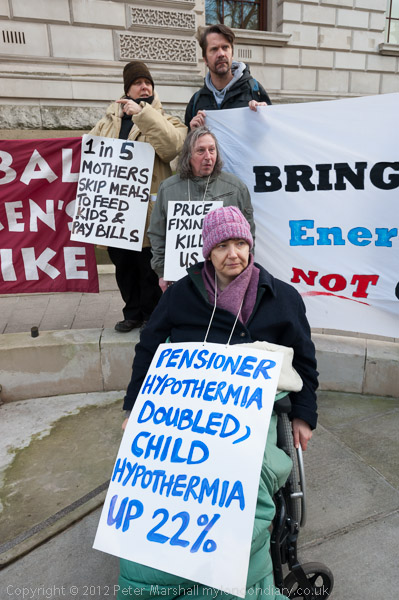Press Inquiry & Cold Homes Kill: On Thursday 29th November 2012 people protested outside the QEII centre as part 1 of the Leveson inquiry into the general culture and ethics of the British media was being published. Later there was a protest outside the Treasury and Parliament against government cuts in benefits and services that were leading to 24,000 extra winter deaths.
Leveson Comes Out

The Leveson inquiry had been set up in 2011 following the News International phone hacking scandal and after a long series of public hearings came to the obvious conclusion the existing Press Complaints Commission was a total failure – and praised Private Eye for refusing to join it. A subscription to that magazine and the many articles it had published over the years could have saved the £5.4 million that Leveson cost.

Leveson was not of course set up to address the overriding problem of the UK media which is the narrow range of its ownership. As the Media Reform Coalition argued “we couldn’t just rely on better press regulation to improve standards are newspapers – we also had to challenge the disproportionate power these corporations held because they so much of our news media.”

The MRC stated in 2023 “Just three companies—DMG Media, News UK and Reach—dominate 90% of the national newspaper market” and go on to show similar resticted ownership of local newspapers and online news platforms.
The news which almost all of us are allowed to hear is controlled by a very few companies and their billionaire owners such as Rupert Murdoch, and Avaaz had brought to the protest large puppet heads of Murdoch and a gagged Prime Minster Cameron with placards ‘End the Murdoch Mafia‘ with a flaming dustbin into which Murdoch lowered the Leveson report.

The industry response to Leveson was to establish in place of the Press Complaints Commission the almost equally toothless Independent Press Standards Organisation (IPSO) which my union, the NUJ labelled a “pointless so-called regulator” and the Hacked Off campaign described as a sham “owned and controlled by the very newspapers it is supposed to regulate” which does nothing to stop them.
The Press Recognition Panel (PRP) was set up by Royal Charter in 2014 with the duty to establish whether any press regulator met the standards set by Leveson. IPSO declined to apply for recognition but an independent body IMPRESS founded in 2016 has gained recognition.

IMPRESS thas been rejected by all the major national papers and most regional and local papers but now regulates “more than 100 publishers, publishing over 200 publications across the UK.” Most of these are small and local independent print or on-line publishers including many on the left. Among them are Novara Media, Skwawkbox and The Canary.
As well as failing to legislate on setting up the independent regulatory body which Leveson concluded was needed, the Tories later quietly shelved the second part of the inquiry into extent of unlawful or improper conduct within news organisations and the extent of police complicity. It was a clear demonstration of the power held by Mudoch over our government.
Cold Homes Kill Treasury Protest

Over 50 people turned up outside Parliament and the Treasury to protest against the cuts made by George Osborne and the government’s energy policies which are leading to 24,000 extra winter deaths.

The protest on the day that Energy Secretary, Ed Davey, was introduing the Energy Bill to Parliament was organised by Fuel Poverty Action along with Disabled People Against Cuts and the Greater London Pensioners’ Association.

Other organisations taking part include Single Mothers’ Self-Defence, Southwark Pensioners’ Action Group and WinVisible (women with visible and invisible disabilities).

Many came with plastic silver reflective coated ‘space blankets’ to wear, and there were three ‘tombstones’ with the messages ‘George Osborne Your Cuts KILL’, ‘Gas Power = Killer Bills’ and ‘24,000 Winter Deaths – Big Six Profits up 700%’.

As speakers at the open mike in front of the Treasury on Horse Guards Road said, many were now having to choose between keeping warm and eating – heat or food – and could not afford to do both adequately. Food banks were now common but often unable to keep up with demand, and libraries where many went to keep warm were being closed.

Hypothermia, even among children, was on the increase, had doubled among pensioners and many disabled people had special needs for heating – and some were suffering from having their benefits removed by unfair Atos work capability tests – often to have them eventually restored on appeal, but with no or inadequate means for months before this happened.

Police tried to keep them off the steps of the Treasury but they declined to move and eventually police came and pushed them down, sometimes with rather more than necessary force, but the rally continued on the pavement. Among the speakers was Green Party leader Natalie Bennett.

There were some further confrontations with police as the protesters moved around the area and protested on the pavement in front of parliament, where there was some hilarity as police came to tell them there has to move as “a Royal movement” was about to take place (they didn’t) and the protest ended with photographs on the grass of Parliament Square with the House of Commons and Big Ben as background.
More pictures on My London Diary at Cold Homes Kill Treasury Protest.
Flickr – Facebook – My London Diary – Hull Photos – Lea Valley – Paris
London’s Industrial Heritage – London Photos
All photographs on this page are copyright © Peter Marshall.
Contact me to buy prints or licence to reproduce.